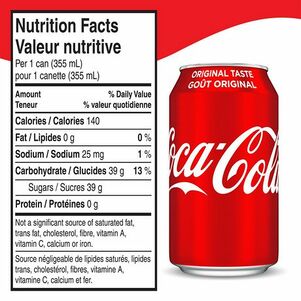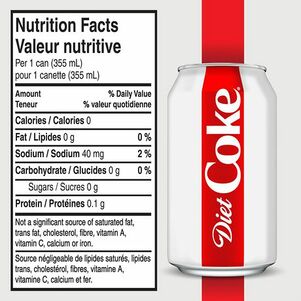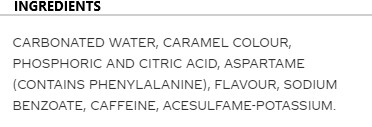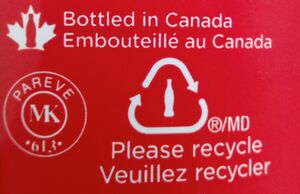Course:FNH200/Assignments/2020/Coca Cola
Introduction
The products we have chosen to compare are the original Coca Cola and Diet Coke.
A cool, carbonated, icy drink during the summer is a delicious choice! However, it's a difficult decision between Coca Cola and Diet Coke. Which one would you drink? The factual information that we have provided you will allow you to make your own decisions, as well as identify the different qualities of each product to see which one would most suit your thirst.
Original Cola & Diet Coke: Nutritional Facts and Labels




Ingredient Lists
Ingredients
- Coca Cola: Carbonated water, Sugar, Glucose, Caramel Colour, Phosphoric Acid, Natural Flavour, Caffeine, Sodium Benzoate, Potassium Sorbate, Niacinamide (Niacin), Guarana Extract, Pyridoxine Hydrochloride (Vitamin B6)[1]
- Diet Coke: Carbonated Water, Caramel Colour, Phosphoric and Citric Acid, Aspartame (contains Phenylalanine), Flavour, Sodium Benzoate, Caffeine, Acesulfame-Potassium[2]
Sugar Substitues & Additives
Sugar substitute
- Aspartame[3]: Aspartame contains 4 calories per gram (g), similar to sugar. It is, however, around 200 times sweeter than sugar. It is a widely used, low-calorie, artificial sweetener and one of the most popular sugar substitutes in low-calorie food and drinks, including diet sodas. It is also a component of some medications. Only a tiny amount of aspartame is necessary to sweeten foods and drinks. For this reason, people often use it in weight-loss diets.
- Acesulfame-Potassium[4]: Acesulfame-potassium, also known as acesulfame K, or ace K — is an artificial sweetener. It is around 200 times sweeter than sugar and is used to give food and drinks a sweet taste without adding calories. Acesulfame works by stimulating the sweet-taste receptors on the tongue, so a person can enjoy the taste of sweetness without consuming sugar.
Additives
- Citric Acid[5]: Citric acid is found naturally in citrus fruits, especially lemons and limes. It’s what gives them their tart, sour taste. A manufactured form of citric acid is commonly used as an additive in food, cleaning agents, and nutritional supplements.
- Phosphoric Acid[6]: Phosphoric acid is a colourless, crystalline liquid. It gives soft drinks a tangy flavor and prevents the growth of mold and bacteria, which can multiply easily in a sugary solution. It is a common additive in processed food.
- Artificial sweeteners[7]: Artificial sweeteners are used in many diet foods and beverages to enhance sweetness while reducing calorie content. The artificial sweeteners that are included in Diet Coke are aspartame and acesulfame potassium.
- Sodium Benzoate[7]: Sodium benzoate is a preservative often added to carbonated drinks and acidic foods like salad dressings, pickles, fruit juices and condiments. It has been generally recognized as safe by the FDA, but several studies have uncovered potential side effects that should be considered.
Compare & Contrast
- Diet coke contains two kinds of sugar substitute that is significantly different from normal Coca Cola, Aspartame and Acesulfame-Potassium, that makes it consequently low on calories and avoid the increase of blood glucose level.
- Normal Coca Cola contain natural flavorings, carbonated sugar, and glucose while diet coke has to find other substitute.
- Caffeine is added into both the original coca cola and diet coke for target customer who is in need of being energized. While being energized, Coca cola might put customer in risk of addiction to caffeine.
- Both normal Coca cola and diet coke contain sodium benzoate, which helps the preservation of products.
Labels
Detailed Descriptions
The labels on both Coca Cola and Diet Coke have descriptions that display the following:
- Name of the product: Coca Cola and Diet Coke. Coca Cola has the words “Original Taste” and the Coca Cola logo on it. Diet Coke does not, only displays “Diet Coke”.
- A nutrition facts table showing the amount per beverage and daily value (in percentage) of calories, fat, sodium, carbohydrates and protein.
- List of ingredients
- Description of insignificant amounts of other nutrients: “Not a significant amount of saturated fat, trans fat, cholesterol, fibre, vitamin A, vitamin C, calcium and iron”. This claim is shown on both Original and Diet Coke
- Best before date
- Caffeine content: "34 mg per 355 mL".
- Manufacturer details: email and telephone number
Information in Compliance with Food Regulatory Requirements
The labels of Coca Cola and Diet Coke comply with food regulation standards as listed in Lesson 04[8] of FNH 200. The "Consumer Packaging and Labelling Act and Regulations" state the specified standards that must be met for regulated food products[9] before they can be sold to consumers.
Original Coca Cola

In Canada, bilingual labelling is found on the carbonated beverage printed in both English and French. The common known names are referred to as a type of "Coca-Cola or Coke" which can be used interchangeably. Descriptions are legible and large enough to clearly read, which benefits consumers who want to know what types of ingredients are found in their beverages and foods. The container displays the amount that it can hold imprinted on its label, as stated on the label the volume of the container holds 355 millilitres.
Country of origin, the certified producer as well as information regarding the disposal of the container is mentioned on the label. Expiration dates are usually printed on the bottom of of the Coca Cola can, however they can be found on either the bottled cap or upper sides of a plastic bottled container.
Symbols on Coca Cola Label
- Pareve MK 613: Cola products are certified by "MK - Canada's Kosher Certifier[10]".
- Coke Bottle in Maple Leaf: Bottled and manufactured in Canada.
- Coke Bottle Encircled by Arrows: Coke bottles and cans are recyclable.
Diet Coke
Bilingual labelling is expressed in both English and French, like Coca Cola products. The name of the product is flashed on the side of the can in a large font, and includes legible print of the nutritional facts and ingredients. However, unlike the original Coca Cola, Diet Coke has "No sugar" and "No calories" listed within their nutritional facts. The indication of "No sugar" shows that it has been replaced by alternative sweeteners.
Country of origin, certified producer and disposal of the container is printed onto the label as well. Expiration dates are printed beneath the can, and again it can be printed in other areas in regards to the type of container the beverage is bottled in.
| Food Labelling Requirements | Descriptions |
|---|---|
| Bilingual labelling |
|
| Common name of food |
|
| Country of origin |
|
| Date marking and storage instruction |
|
| Identity and Principle Place of Business |
|
| Irradiated food |
|
| Legibility and location |
|
| List of ingredients |
|
| Nutrition fact table |
|
| Net quantity of the food |
|
| Sweeteners |
|
| Other mandatory information |
References
- ↑ "Coca Cola Canada".
- ↑ "Coca Cola Canada".
- ↑ Marengo, Katherine. "What are the side effects of aspartame?".
- ↑ Seitz, Adrienne. "The benefits and risks of acesulfame potassium".
- ↑ Van De Walle, Gavin. "What Is Citric Acid, and Is It Bad for You?".
- ↑ Pletcher, Peggy. "Is Phosphoric Acid Bad for Me?".
- ↑ 7.0 7.1 Link, Rachel. "12 Common Food Additives — Should You Avoid Them?".
- ↑ Chan, Judy. (2020). "Food Labelling Requirements".
- ↑ "Food Labelling for Industry". Government of Canada. Retrieved July 19, 2020.
- ↑ "MK-Canada's Kosher Certifier". 2020. Retrieved July 19, 2020.
| This Food Science resource was created by Course:FNH200. |
